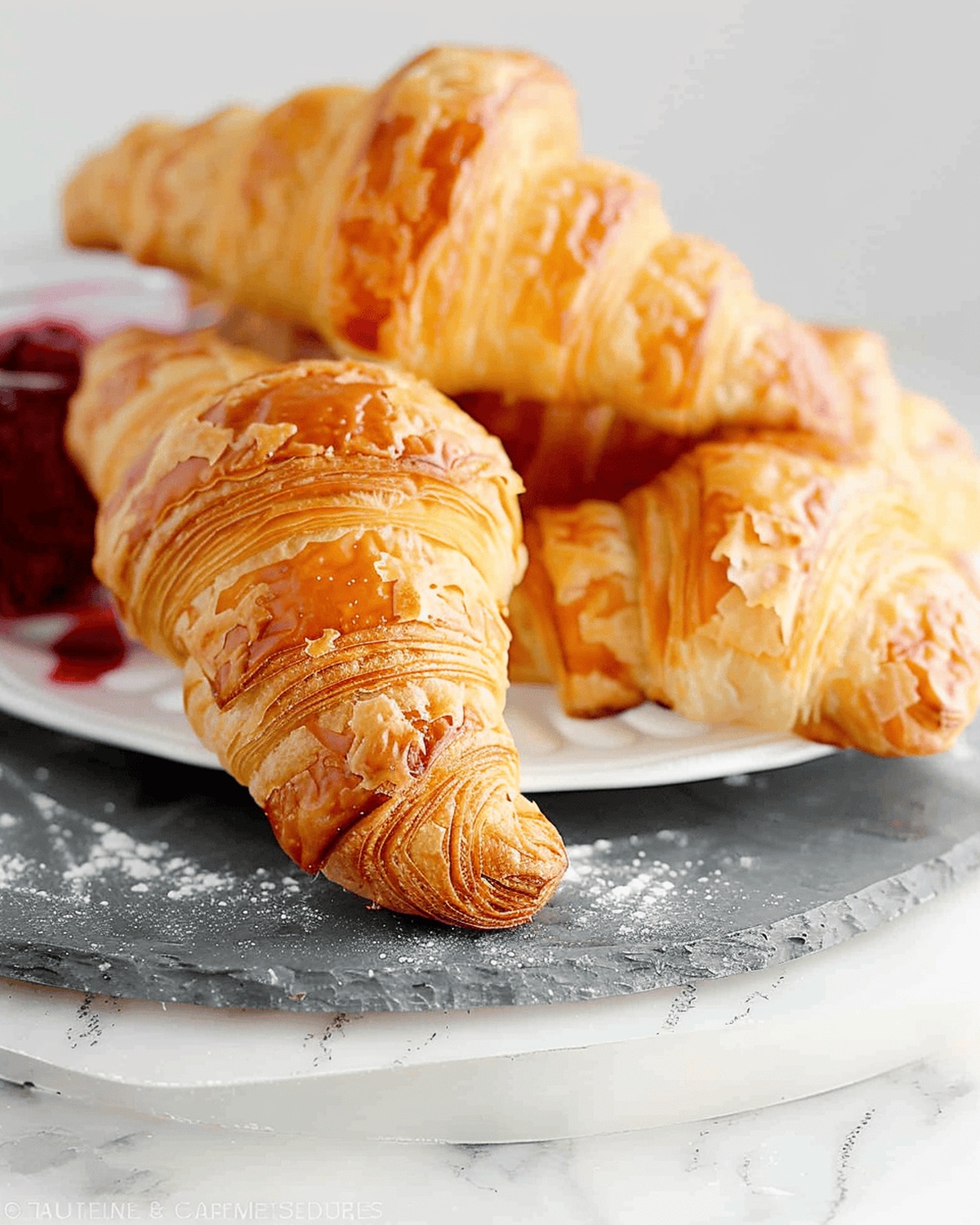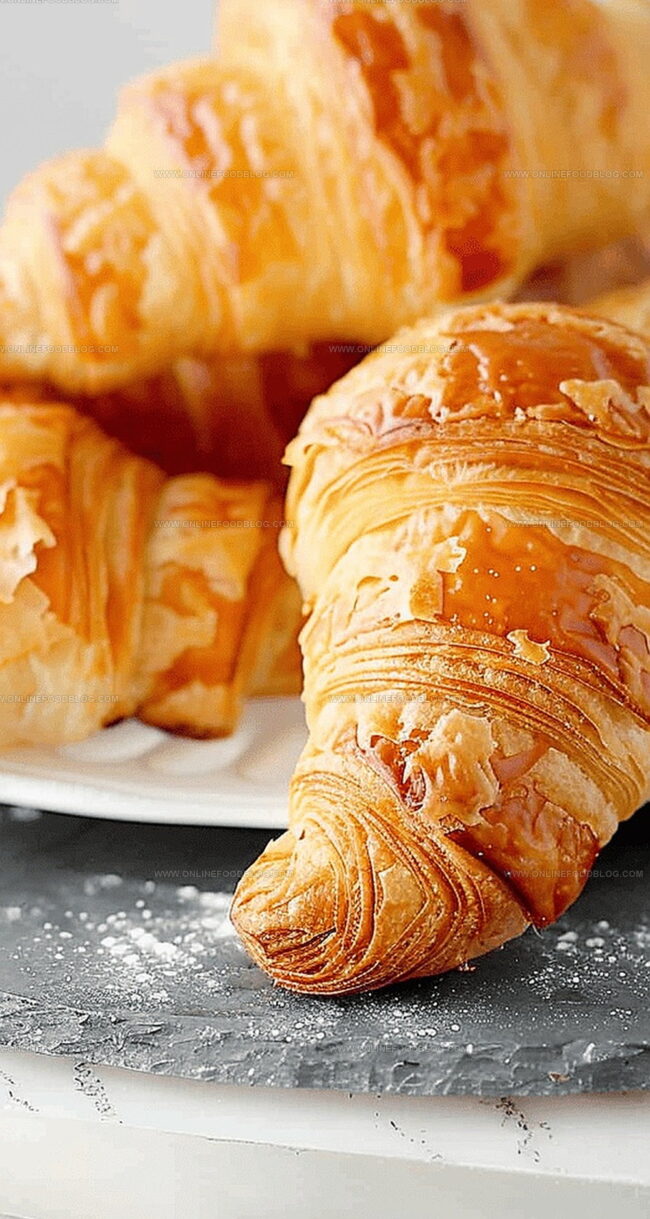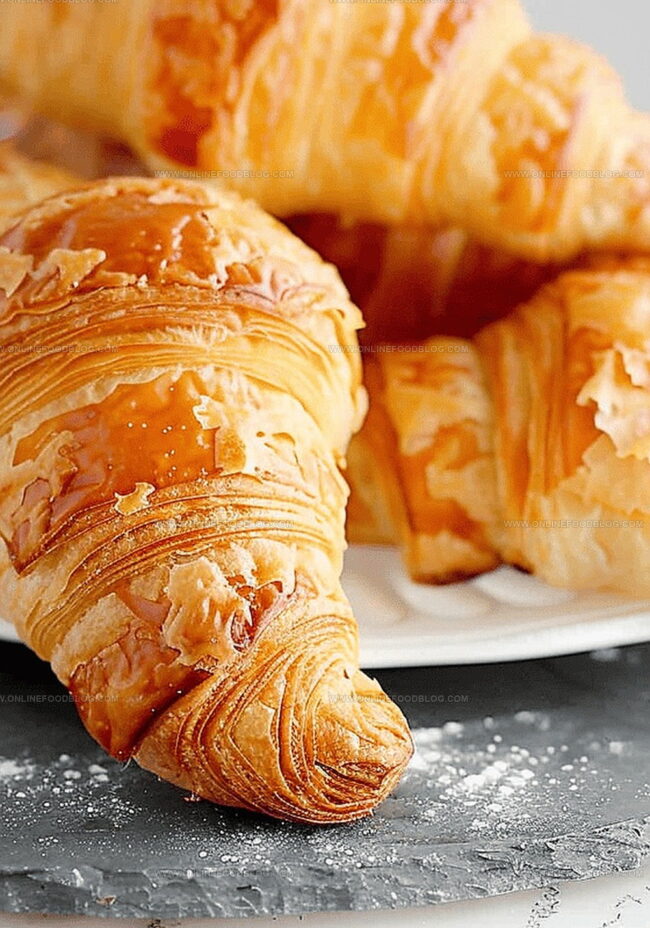The Flakiest Homemade Croissants Recipe Ever Baked
Golden, buttery layers that melt in your mouth define these homemade flaky croissants that promise bakery-quality deliciousness right from your kitchen.
Crafting these delicate pastries might seem intimidating, but with careful technique and patience, you can master the art of croissant making.
Each fold creates delicate, gossamer-thin layers that crisp beautifully when baked to a rich, amber color.
The process demands precision, but rewards you with an incomparable texture that store-bought pastries never achieve.
European bakers have perfected this technique over generations, passing down secrets of laminated dough that create irresistible, golden crescents.
Rich, buttery, and wonderfully light, these croissants will transport your senses to a charming Parisian café.
Quick Recipe Overview
Flaky Croissant: Ingredient List
For The Base:For Liquid Components:For Butter and Enrichment:Rolling Pins and Tools for Homemade Croissants
Steps for Folding and Baking Flaky Croissants
Create a smooth, elastic dough using flour, yeast, water, and milk. Knead until the mixture becomes soft and pliable, allowing the ingredients to blend seamlessly.
Transform cold butter into a creamy, spreadable square. Mix with a touch of flour to achieve a silky consistency that will later create those signature flaky layers.
Carefully wrap the butter within the dough, creating a delicate package that will become the secret to incredible texture. Seal the edges completely to prevent any leakage.
Roll and fold the dough multiple times, creating countless delicate layers. Each fold builds incredible complexity and depth of flavor, transforming simple ingredients into a culinary masterpiece.
Cut the dough into elegant triangles, then roll each piece from the wide end to the pointed tip. This technique ensures the classic croissant shape that promises a perfect balance of crispy exterior and tender interior.
Allow the shaped croissants to expand and become puffy, capturing the airiness that makes them irresistible. This crucial resting period develops their characteristic light and delicate structure.
Brush with a golden egg wash and bake until the croissants turn a beautiful amber color. The heat will create those signature crispy, flaky layers that shatter delicately with each bite.
Buttery Tweaks or Fillings You Can Add
Best Ways to Serve Croissants Warm
Croissant Storage Ideas to Maintain Texture
Print
Golden Croissants
- Total Time: 3 hours 35 minutes
- Yield: 13 1x
Description
Mastering this homemade flaky croissants recipe requires patience and precision from French baking traditions. Delicate layers of buttery dough create a golden, crisp pastry that rewards careful technique with remarkable flavor and texture.
Ingredients
- 1 large egg
- 3 ½ cups (440 g) all-purpose flour
- 2 tablespoons (15 g) all-purpose flour
- 1 ½ cups (340 g or 3 sticks) unsalted butter
- 1 cup (240 ml) whole milk
- ½ cup (120 ml) water
- 2 ¼ teaspoons (7 g or 1 packet) instant yeast
- ⅓ cup (67 g) granulated sugar
- 2 teaspoons (12 g) salt
Instructions
- Preparation: Remove milk and butter from refrigerator. Cube butter into small pieces.
- Mixing: In a stand mixer, combine flour, sugar, and salt. Activate yeast by sprinkling directly into flour mixture or hydrating in warm water until foamy.
- Dough Development: Knead ingredients until a smooth, elastic dough forms. Adjust consistency by adding flour or water as needed. Shape into a ball and let rest in a warm spot, covered with plastic wrap.
- Butter Preparation: Cream butter with flour until smooth and uniform. Shape into a neat square using plastic wrap and refrigerate.
- Lamination Process: Roll out proofed dough on a floured surface. Place chilled butter in the center, folding dough corners to completely encase butter. Chill the dough packet.
- Folding Technique: Roll dough into a rectangular shape, perform a tri-fold like a letter. Refrigerate. Repeat this folding process two more times, ensuring precise layering between each fold.
- Resting Phase: Allow laminated dough to rest overnight in the refrigerator.
- Shaping: Remove dough, trim edges cleanly. Cut into triangular shapes. Roll each triangle from the wide base to the narrow point, creating classic croissant shape.
- Final Proofing: Arrange croissants on a baking sheet. Let rise in a warm environment until puffy.
- Baking: Preheat oven to the specified temperature. Brush croissants with beaten egg. Bake, rotating midway, until achieving golden-brown perfection. Cool on a wire rack before serving.
Notes
- Yeast Activation Tip: Ensure water temperature is between 100-110°F for optimal yeast performance, preventing potential dormancy or premature death.
- Butter Technique: Keep butter cold and malleable but not hard; ideal consistency resembles soft play-dough for seamless lamination.
- Dough Resting Strategy: Allow extended refrigeration periods between folding to develop complex flavor and enhance structural integrity of layers.
- Rolling Precision: Use consistent, gentle pressure when rolling to maintain even butter distribution and create delicate, crisp layers.
- Prep Time: 45 minutes
- Cook Time: 20 minutes
- Category: Breakfast, Snacks
- Method: Baking
- Cuisine: French
Nutrition
- Serving Size: 13
- Calories: 267
- Sugar: 6 g
- Sodium: 91 mg
- Fat: 16 g
- Saturated Fat: 10 g
- Unsaturated Fat: 5 g
- Trans Fat: 0 g
- Carbohydrates: 27 g
- Fiber: 1 g
- Protein: 4 g
- Cholesterol: 36 mg




Mia Reynolds
Food Writer & Home Cooking Specialist
Expertise
Easy Home Baking, Recipe Writing and Storytelling, Local and Seasonal Ingredients, Baking for Beginners
Education
New England Culinary Institute (NECI), Montpelier, Vermont
Community College of Vermont, Winooski, Vermont
Mia Reynolds fell in love with baking as a teenager experimenting in her family kitchen. Her passion took her to New England Culinary Institute, where she learned practical pastry techniques, and later to Community College of Vermont to deepen her understanding of food management.
Mia combines clear, simple baking instructions with heartwarming stories, making home baking approachable for everyone.